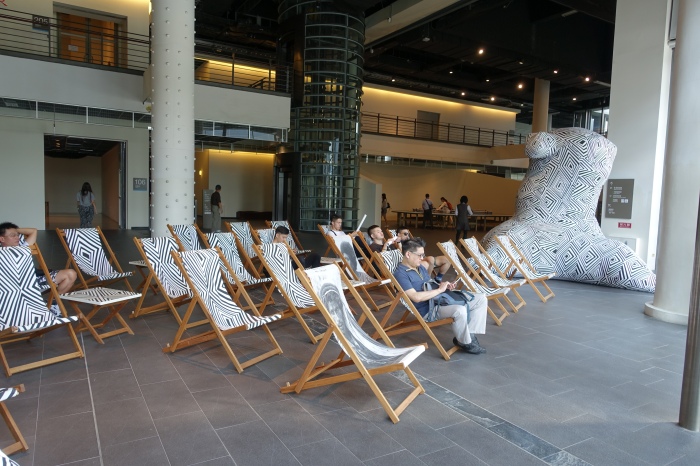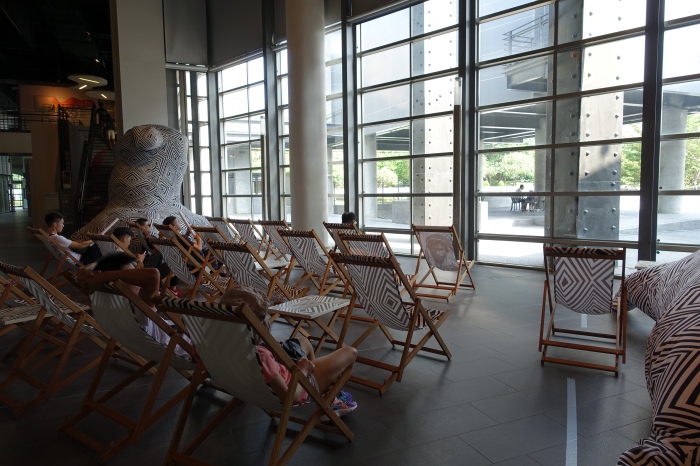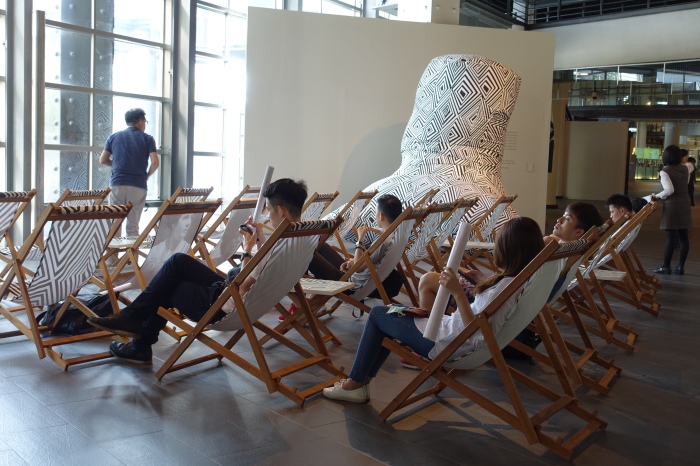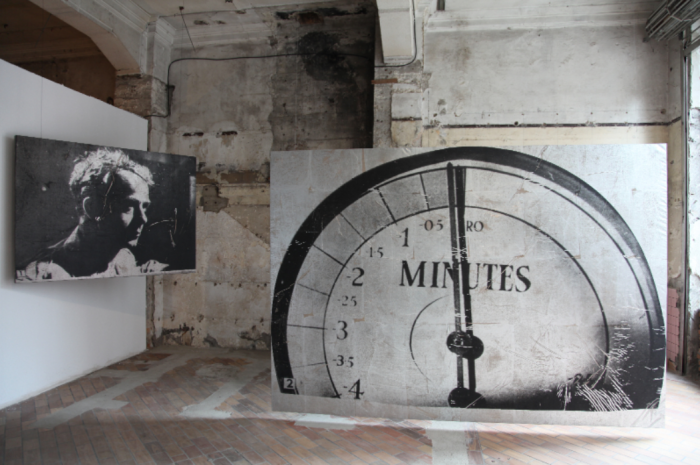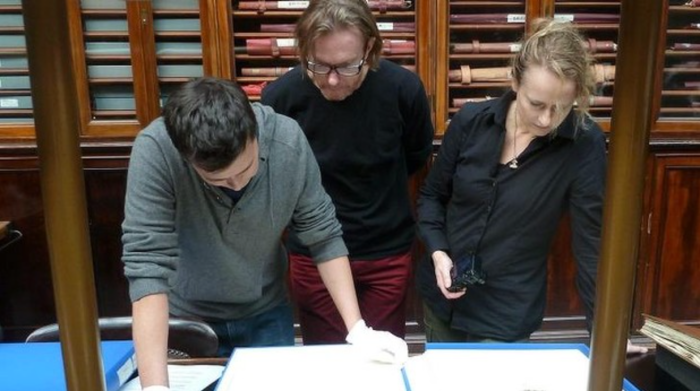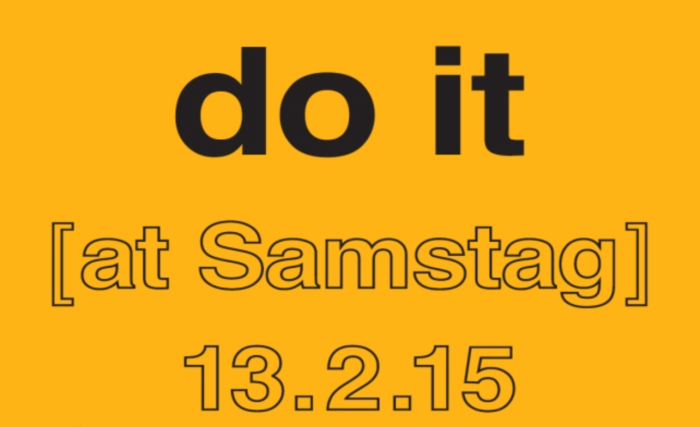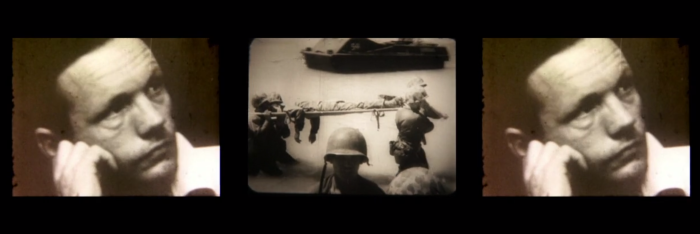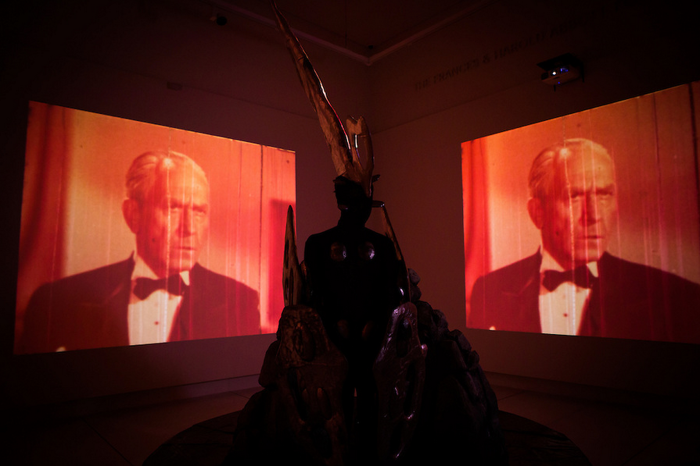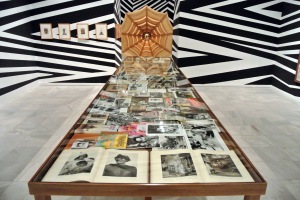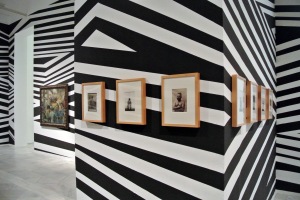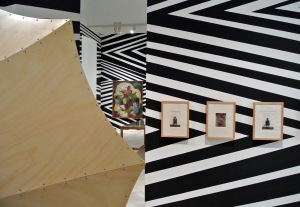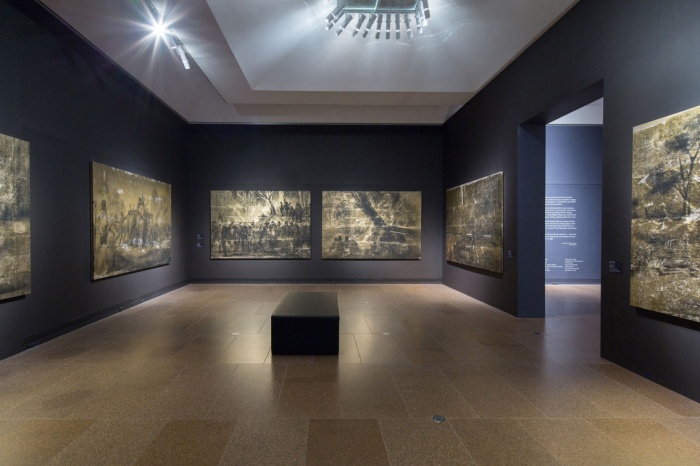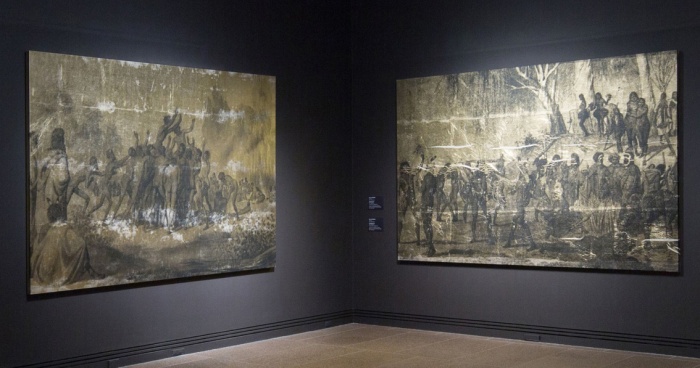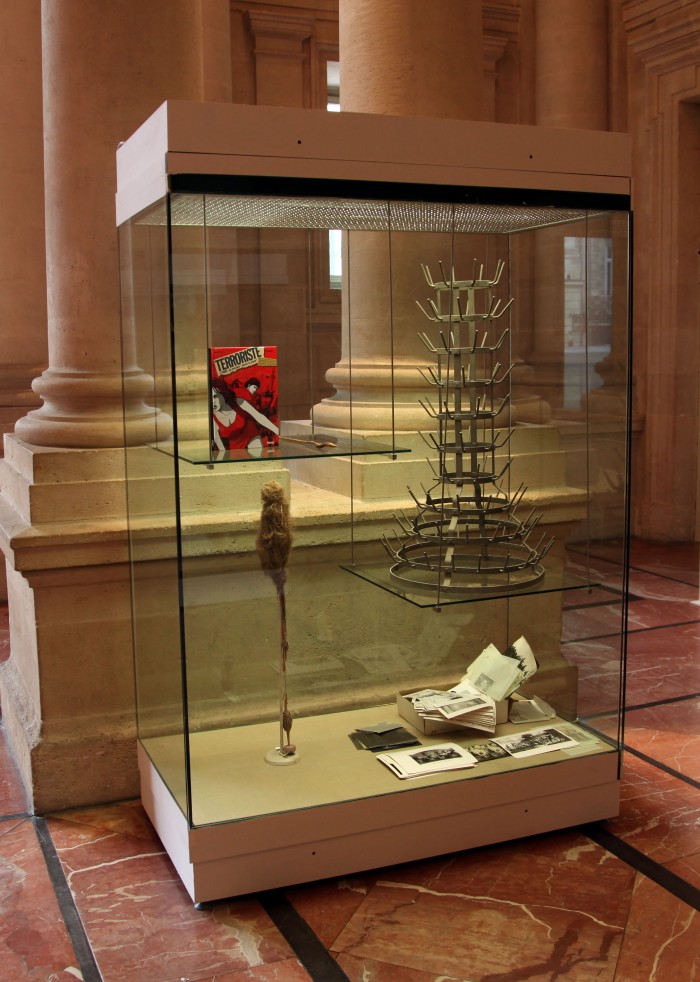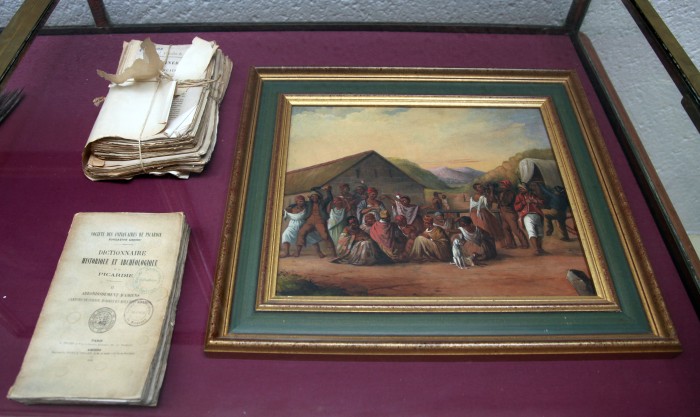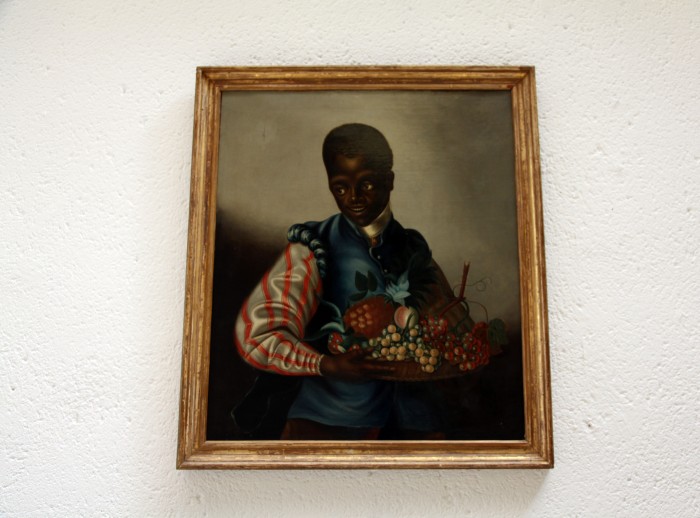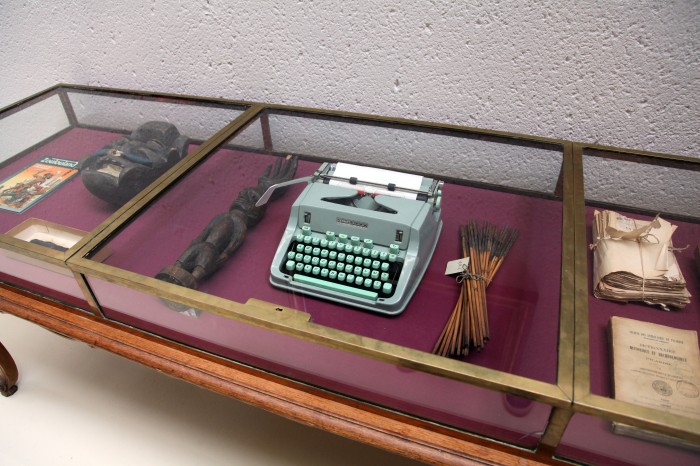Archive for the ‘Group exhibitions’ Category
‘Ancestral Worship’, 2010 at the 2015 Asian Art Biennial
Artist Making Movement
2015 Asian Art Biennial
19 September – 6 December 2015
National Taiwan Museum of Fine Arts
Anatomie de la mémoire du corps in Neverwhere at Gaia Gallery
Neverwhere
Gaia Gallery, Istanbul
14 August – 12 September 2015
Curated by Vikki McInnes for Australia in Turkey 2015: Celebrating Contemporary Australian Culture
Supported by Asialink Arts.
 Image: Anatomie de la mémoire du corps : au-delà de la Tasmanie, 2013 (detail)
Image: Anatomie de la mémoire du corps : au-delà de la Tasmanie, 2013 (detail)
Curatorial Concept from Asialink
Neverwhere brings together the work of eight contemporary Australian artists to disturb distinctions between our real and imagined selves, between authentic and fantastical scenarios. Works in this exhibition perform and postulate identity however narratives are largely informed by external – often mysterious – forces, both seen and unseen. The characters and identities represented here all seem to have fallen through the cracks of reality and landed somewhere different, into an underside; somewhere that is Neverwhere.[1]
Neverwheremight be read here as Australia, of course, and the works suggestive of how nations, identities and selves are implied, inflected and inferred. At the exhibition’s very outset, Kathy Temins Audition for a pair of Koalas (2004) sets up this proposition, while simultaneously complicating it. While she was undertaking a residency in New York, the artist advertised for American actors to attend auditions and impersonate a pair of koalas mating. Most people that came to her auditions had never seen a koala in the flesh, of course, and brought to the work their own projections and fantasies about how a koala – and, by extension, an Australian – might behave.
Behaviour of marginal characters is highlighted in Captain Thunderbolt’s sisters, a video Mikala Dwyer made with Justene Williams in 2010. The two artists, dressed in striped prison outfits, bushranger helmets and high heels, clamber around a circular bunker on Sydneys Cockatoo Island – the site of a former prison and reform school for errant girls. Either invoking, or possessed by, the dead girls’ spirits, the artists bash violently at the metal fixtures; citing Australia’s colonial history at the same time hammering societal boundaries. Such transgressive female agency is also evident in Miss Universal (2014), Claire Lambes recreation of a 1976 image from Crazy Horse (the infamous Parisian cabaret). In this work, Lambe selects Australian women with real body types, and forces her subjects into clay shoes, impeding their movement but lending an air of absurdity to the scenario. Of course, it can be seen as a powerful statement to turn your back to the audience and these women seem determined to wrestle power back from the viewer.
Power relations are clearly at work in Tony Garifalkis’ Mob Rule (2013) in which the artist has obscured the faces of national leaders and military figures with black spray paint, referencing his interest in forms of censorship as both a political and an aesthetic gesture. As with Lambes work, these images serve to draw attention to the ways in which power (both social and political) is signified and performed through popular culture and in our collective imagination.
The urge to perform, or make things perform, is evident in each of the works in Neverwhere, but perhaps most explicitly in Clare Milledge’s Academic Suspicion: Staging a Hermeneutics of Incommensurability (2015). The artist invites active participants into the shadowy world she has created, which is full of motifs she has borrowed from tribal art, mythology and spiritualism among other sources. However, Milledge’s rituals seem to be invented by and only known to the artist and, as viewers, we are never quite sure what is being celebrated. As in the worlds inferred by Mikala Dwyer, invisible psychic energy abounds.
Play is important here, too; in the works of Milledge and Dwyer, but also in those by Veronica Kent and Lou Hubbard. But these are deeply unsettling forms of play; full of dark imaginings rather than innocent abandonments. Typifying this ambivalence is the figure of the clown; a keenly divisive figure, engendering fear and loathing, as much as it does laughter. This contradiction is tested by Kent in Clown Transfer #1 (2010) but also in Cloak(2011), in which a resting child is watched over by a maternal figure – presumably her mother but, in fact a monstrous one-eyed character. The work conjures a complex relationship between mother and child, but also between subject and object. Performing and seeing are equally important in Hubbards Eye Ops (2013), for which the artist enacts a series of operations on confectionary eyeballs, examining the dysfunctional eyes as an optometrist might, before performing the necessary corrections as a surgeon would. Though performed in deadly earnest, the work ultimately relies on absurdity to render the familiar so strange. As with much in Neverwhere, there is a continually shifting stance between sincerity and satire and a propensity towards darker psychological turns.
Brook Andrew turns the gaze firmly back on Australia with Anatomie de la mémoire du corps : au-delà de la Tasmanie (2013). Interested in uncovering the often-invisible histories of colonial societies, the artist’s work is deeply informed by his own mixed cultural background. Andrew offers a wunderkammer filled with human bones alongside rare books, objects and ephemera relating to the legacy of colonisation fraught with strange juxtapositions that problematise any straight reading of the work. These new combinations, however, become a personal exploration with new possibilities, stories, histories and implications.
Such merging of facts, fictions and fantasies runs rampant throughout the exhibition. Works challenge given cultural and social perceptions and draw attention to the unseen and to our own personal relationships with memory and ritual. We are left suspended in a time and space of uncertainty and contemplation: somewhere and anytime. Neverwhere.
[1] Neverwhere, the exhibition, takes its title from an urban fantasy novel and television series set in London Below, a magical realm that coexists with the familiar city of London (referred to as London Above). London Below is a dark mysterious place, where talking rats and violent assassins run wild, and magic is slippery and capricious. The series was pronounced in The Guardian as ‘a creepy, funny and deeply odd gem’. (Neil Gaiman, Neverwhere, HarperCollins, 1996).
The exhibition catalogue is available to download here.
The Asialink Visual Arts Touring Exhibition Program is supported by the Australian Government through the Department of Foreign Affairs and Trade. Asialink Arts is supported by the Australian Government through the Australia Council, its principal arts funding body, and by the Visual Arts and Craft Strategy, an initiative of the Australian, State and Territory Governments.
Partner: Faculty of VCA & MCM
Current & forthcoming events
RMIT Design Hub
Pavilion 1, Level 10
Until 29 May, open daily
SMUDGE is a new collaboration between Phillip Adams BalletLab and Brook Andrew, in partnership with RMIT Design Hub. Phillip Adams and Brook Andrew have embarked upon a radical collaboration through which they surrender their usual artistic expression to swap cultural identities and artistic responsibilities. In SMUDGE, the choreographer becomes the artist, and the artist the choreographer.
The project includes four performers: Anna Kuroda, Gregory Lorenzutti, Anna Seymour and Lilian Steiner, who will be directed by Andrew in a set created by Adams. Adams and Andrew will activate SMUDGE by taking turns in placing objects into the creative and performative space.
The development phase of Phillip Adams BalletLab’s SMUDGE at RMIT Design Hub is supported by Besen Family Foundation and City of Melbourne. Images: Brook Andrew, The Cell. Photo: Roger D’Souza. Commissioned by Sherman Contemporary Art Foundation, Sydney 2010 | Phillip Adams BalletLab, Tomorrrow. Photo: Jeff Busby.
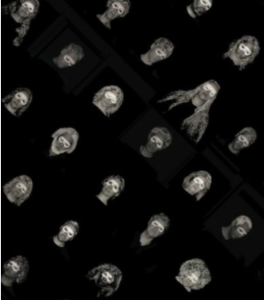
Art in the Time of Colony – Book Launch
Khadija von Zinnenburg Carroll in conversation with Brook Andrew
Thursday 14 May,
6.00 – 7.00pm
William Macmahon Ball Theatre, Room 107 | Old Arts Building
University of Melbourne
Free
In this lecture Khadija von Zinnenburg Carroll presents her method of writing the history of Australian art in the time of (post)colony as one of perpetual anachronism. Through a history of anachronic exhibitions of colonial material in Melbourne by contemporary artists the argument traces shifts between alienation in the museum vitrine and irreverent vitrinizations. The evening’s discussion also marks the launch of the book ‘Art in the Time of Colony’ by focusing on how anachronistic artists engage in a process of disalienation. Brook Andrew will moderate a debate about the taboo and critical import of working with Aboriginal archives.

Sanctuary: Tombs of the outcasts
The Ian Potter Museum of Art, the University of Melbourne
Until Sunday 9 August
In conversation: Brook Andrew & Dr Vincent Alessi
Tuesday 19 May, 1.00- 2.00pm
Free. No booking required.
Special viewing and panel discussion with Professor Marcia Langton, Dr Vincent Alessi, Brook Andrew, and Maxine McKew
Wednesday 27 May, 5.00- 6.15pm
Free. Book here.
** Exhibition catalogue available soon **
Sanctuary: Tombs of the outcasts seeks to give voice to aspects of history which have become silent and reveals Australia as a place of sanctuary. It aims to ask questions about what we remember, personal and collective, and how we commemorate.
Image: In the mind of others, 2015.
Victorian redgum, carbonised redgum, glass, brass, brass breastplate. Photograph: Christian Capurro.
John Wardle Architects & Spacecraft Studio
Wednesday 20th May
On Top of the World invites local & visiting, artists, architects & thinkers to contribute to contemporary debates through an informal series of talks on the top floor of Rokeby Street.
Register interest to attend via email here.
Image: Time, 2012. Installation view: The Floating Eye, Sydney Pavilion at the Shanghai Biennale.
The Australian Print Workshop
Brook Andrew, Tom Nicholson & Caroline Rothwell.
Lead by APW Director Anne Virgo OAM, with fellow curator Dr Nicholas Thomas, from the University of Cambridge Museum of Archeology and Anthropology.
The group have recently returned from a research trip in Cambridge and London.
Article by Stephanie Bunbury in The Age.
Image: The Age. Supplied.
‘do it (adelaide)’ | artist instructions at Samstag Museum
Conceived by European curator Hans Ulrich Obrist and managed by Independent Curators International (ICI), New York, do it (adelaide) will be the latest incarnation of this global art project.
do it began in Paris in 1993 as a result of a discussion between Obrist and artists Christian Boltanski and Bertrand Lavier about how to make exhibitions flexible and open-ended. Would an artist’s work be transformed if others made the artwork?
Each do it exhibition is uniquely site-specific because it engages the local community in a dialogue that responds to and adds a new set of instructions, while it remains global in the scope of its ever-expanding repertoire. This also means that the generative and accumulative aspects of do it’s ongoing presentation are less concerned with notions of the “reproduction” or materiality of the artworks than with revealing the nuances of human interpretation in its various permutations and iterations. In this way, do it is able to bridge the gaps between the temporalities of past, present and future.
This open exhibition model has become the longest-running and most far-reaching exhibition to ever take place, giving new meaning to the concept of the “Exhibition in Progress.”
do it (adelaide)
Friday 13 February – Saturday 25 April 2015
Anne & Gordon Samstag Museum of Art
Text from: Anne & Gordon Samstag Museum of Art and Independent Curators International
De Anima to be presented at RMIT Design Hub and associated to RECHARGE: the Experimenta 6th International Biennial of Media Art
DE ANIMA by Brook Andrew is a major new video installation originally presented as part of The Cinemas Project, Bendigo Art Gallery in 2014 and curated by Bridget Crone. De Anima will be re-contextualised for its inaugural presentation in Melbourne at RMIT Design Hub through a program led by Brook Andrew in collaboration with RMIT Design Hub researchers and included as part of RECHARGE: the Experimenta 6th International Biennial of Media Art. Entering the installation, visitors will become lost in between worlds of fictions and truths, challenging and blurring the space between photography, sculpture, video and performance. De Anima pressures the visitor to be immersed in its midst by donning a costume and being ready to experience a new view as the small eyes in a forest, and perhaps understanding why this world seems awkward for some and a revelation for others.
De Anima includes an ambitious new video with score composed by Theodore Wohng, performed by Benny Dimas and Justin Shoulder and collaging found archival film footage, alongside a series of photographic images and sculptural forms. De Anima offers us an immersive environment to ponder human ego, time, historical ‘facts’ and our responsibility to linking thinking and feeling.
The project aims to question the way in which representations – or pictures of those around us – are produced, digested and reproduced. De Anima questions the power of visual footage and how it is used to persuade ‘us’ to take sides through stereotypes, propaganda and masking other views of earth, war, colonialism, ancestry, the Australian psyche and humanity. Is what ‘we’ believe a real act of reality?
The commissioning of this ambitious work, comes at a significant moment in Andrew’s career following his exhibition 52 Portraits in Melbourne and Paris, his curated exhibition TABOO at MCA, Sydney, and his upcoming exhibition at the Museo Nacional Centro de Arte Reina Sofía, Madrid.
RECHARGE: the Experimenta 6th International Biennial of Media Art, focuses on artists whose work is consciously inspired by and entangled with the past and who use the most contemporary of tools. Recharge asks does knowledge change when it is presented in different cultural contexts and technological forms? By producing unconventional perspectives, can experimental artists illuminate existing knowledge and meaning for a new generation? Can artists lead us to entirely new modes of consciousness?
The exhibition presents works from more than 15 acclaimed Australian and international artists, featuring many new artworks. Media art is inherently multidisciplinary, born out of the processing power of computer technology that made possible, for the first time, a substantial interplay between various media and practices. For the Experimenta 6th International Biennial of Media Art, Artistic Director Jonathan Parsons has selected works that draw from photography, installation, electronic sculpture, interactive and immersive media, robotics, bio art, live art, sound art, 3D printing, animation, film and video.
“The artists in the Experimenta 6th International Biennial of Media Art are alert to both the intimate and the broader cultural contexts through which they move and live. By listening, watching, thinking and making, they recharge knowledge and meaning systems, reinvigorating these systems or radically transforming them. “ [Jonathan Parsons, Artistic Director]
CATALYST: Katherine Hannay Visual Arts Commission
A NETS Victoria exhibition curated by Bridget Crone for The Cinemas Project
De Anima, 2014, is a new 3 channel video work with performance. De Anima includes sculpture, performance and installation. De Anima the video is comprised of found archival film footage and newly filmed footage to reflect on Aristotle’s text on The Soul or De Anima.
Please note this video artwork contains images of people who may be deceased from indigenous and non-Indigenous cultures from the Pacific, Australia, Africa, Asia, Europe and America.
Brook Andrew’s major new work De Anima immerses us in a world of images and sensations. It asks us to question the way we see the world and to consider a new view. Drawing upon Andrew’s extensive personal archive of home movies, war propaganda, ecological and pseudo-anthropological films, De Anima combines and recombines these images with newly shot footage that creates a theatre of sensations: of light, of sound, of image, of images that we feel. Upon entering De Anima, we are immersed in a world of sound and image, and we accept an invitation to see the world anew.
Andrew has worked with performers Mama Alto and Justin Shoulder as well as composer Theodore Wohng (and an extensive crew) to produce the world of De Anima. Each was invited to respond to the question of the soul and the result is a richly, theatrical and world in which difference is celebrated, and the spirit or soul runs riot.
De Anima references one of the great philosophical treatises, Aristotle’s “On The Soul”, in which the soul is considered to be the essence of every living thing (rather than simply belonging to human subjects). Andrew interprets this as a call to consider our responsibility to the life around us in all its myriad forms. We must consider, the artist says, “that humanity is essentially doomed if it sticks to its current course.” In asking us to experience the world differently, Andrew shows us a way that we might embrace our interconnected place in the world, and consider a new worldview.
De Anima is presented as part of The Cinemas Project – a programme of new contemporary art works by five of Australia’s leading artists who include: Mikala Dwyer, Lily Hibberd, Bianca Hester and Tom Nicholson. The artwork produced for The Cinemas Project takes the form of live performance and film replicating the nature of the activity that once took place in many of the early cinema buildings which were at once a meeting place, a theatre, a dance hall as well as a cinema.
The Cinemas Project responds to what we have termed, the spectral spaces of cinema. Spectral suggests ghosts, apparitions, colour and light but is also linked to day-dreaming, speculation and, of course, imagination. The “spectral spaces of cinema” therefore refers to the diverse temporal spaces that are opened up both within the narratives of film, and by acts of reminiscence and memory. The Cinemas Project is therefore not a collection of works about cinema but a series of works that approach ideas of what cinema is, has been and could be…
DE ANIMA CREW LIST
Director: Brook Andrew
Film Consultant: Paola Morabito
Cinematographer: Bonnie Elliott
Editor: Billy Browne
Performers: Justin Shoulder & Mama Alto
Assistant Producer & Production Manager:
Stéphanie Kabanyana
Sound Recordist & Engineer: Nik Harrison
Camera Assistant & Focus Puller: Sky Davies &
Ben Bryan
Grips: Llew Higgins & Dan Mitton
Composer: Theodore Wohng
Set Designer: Bryn Meredith & Brook Andrew
Studio Manager: Trent Walter
Costume Design: Justin Shoulder &
Matthew Stegh
Costume Assistance: Ami Shoulder
Set Assistant: Rosie Kilvert
FILM POST HOUSE
Cutting Edge
SPECIAL THANKS
Nick Godoy at Panavision
Bronwyn Ketels at Cutting Edge
Nic van den Bronk
Anne Walsh
Kieran Dionysus
Hanging Rock Park
Kooyoora State Park
Really Useful Knowledge, Museo Reina Sofia, Madrid.
October 29, 2014 – February 9, 2015
A Solid Memory of the Forgotten Plains of our Trash and Obsessions, 2014, is a new installation commissioned for the exhibition Really Useful Knowledge at the Museo Nacional Centro de Arte Reina Sofía, curated by WHW (What, How and for Whom).
The commissioned work draws on the collections of archives from the artist and the Museo Reina Sofia, Museo de América and Museo Nacional de Antropología and also include existing works Anatomie de la mémoire du corps : au-delà de la Tasmanie, 2013, first exhibited at Galerie Nathalie Obadia, Paris in 2013.
WHW, Museo Reina Sofia source: The notion of “really useful knowledge” emerged at the beginning of the 19th century alongside the workers’ awareness of the need for self-education. In the 1820s and 1830s, working class organisations in the UK introduced this phrase to describe a body of knowledge that encompassed various “unpractical” disciplines such as politics, economy and philosophy, as opposed to the “useful knowledge” proclaimed by business owners who had previously begun to invest more heavily in their companies’ progress through financing workers’ education in “applicable” disciplines like engineering, physics, chemistry and mathematics. In this reference to the long-forgotten class struggles of early capitalism, the title of the exhibition suggests an inquiry into “really useful knowledge” from a contemporary perspective.
The exhibition endeavours to position the notion of critical pedagogy as a crucial element in collective struggles, and explore the tension between individual and social emancipation through education with examples that are both historical and current, and their relation to organisational forms capable of leading unified resistance to the reproduction of capital. In doing so, the exhibition highlights the collective utilization of public resources, action and experiments, either forgotten or under threat of eradication, taking the museum as a pedagogical site devoted to the analysis of artistic forms interconnected with actual or desired social relations.
Organised by Museo Reina Sofía within the framework of “The Uses of Art,” a project by the European museum network L’Internationale.
Brook Andrew:
The aim of this A Solid Memory of the Forgotten Plains of our Trash and Obsessions, 2014, is to create a new installation using archives and art objects that reflect on a cohesive memorial style installation to jog and juxtapose new and existing memories and knowledge that will challenge and perhaps confuse what we perceive as real and imagined to further explore what is ‘useful’ memory in important historically nation changing events. The focus of this research and installation is a comparison between a Spanish and Australian use of, and reflection on, what currently exists as metaphors to remembering the past: how we remember it and to what extent it can be either destroyed or created. Who has the power to create and destroy a monument in remembering particular histories that include fascism, and alternative revolutionary histories?
This project compares visibility to issues of cultural amnesia and monuments in Australia and Spain. The aim of this project is through focused research to create a major new installation using archives and art objects that reflect on a specific idea of ‘cultural amnesia’ that raises public awareness of traumatic life-changing events often absent in monuments and museums. The research outcomes in Madrid will inform the installation outcome in combining personal, private and Spanish community archives, found and borrowed objects, artworks from the Museo Nacional Centro de Arte Reina Sofía and neighbouring Spanish museums.
Research will draw parallels between an Australian and Spanish view of history that is deeply rooted within the idea of ‘cultural amnesia’: how current monuments disappear or do not exist and how the memory of these events is debated through public and community organisations. The lack of notable acknowledgement and visibility of monuments and markers are often absent due to politically strategic conservative thought and historical education government services. This political strategy greatly effects public memory, visibility, struggle and responsibility across communities and societies. The monument is arguably an important and visible marker for all; if no monument exists, cultural amnesia prevails. Therefore it is often through public community and non-for profit organisations where action is upheld within the public eye, often strategies and events that are seen as ‘disruptive’ to the public or scrutinized as disturbing the peace or concocting and exaggerating truths of history. The question here is: Who’s truth is the real?
‘Really Useful Knowledge’, Museo Nacional Centro de Arte Reina Sofía
Brook Andrew to exhibit in the group exhibition Really Useful Knowledge at the Museo Nacional Centro de Arte Reina Sofía, Madrid.
Really Useful Knowledge
29 October 2014–23 February 2015
Museo Nacional Centro de Arte Reina Sofía
Following text from e-flux.com
The notion of ‘really useful knowledge‘ originated with the rise of the workers’ awareness of the need for self-education in the early 19th century, when workers’ organizations in the UK introduced this phrase to describe a body of knowledge that encompassed various ‘unpractical’ disciplines such as politics, economics and philosophy, as opposed to the alleged ‘useful knowledge’ proclaimed by business owners, who had begun investing in their companies’ development through funding the education of their employees in ‘applicable’ skills and disciplines. In its reference to the long-forgotten class struggles of capitalism’s early years, the title of the exhibition suggests an inquiry into ‘really useful knowledge’ from a contemporary perspective.
Really Useful Knowledge (curated by What, How and for Whom?/WHW) starts from the position that the ‘battle for education’ was always central for “the very survival of socialism as the pedagogy of a world-view,” and assesses the success of politics of recent social movements whose critical pedagogy has proved capable of illuminating the threats that capitalism poses for human lives, the environment and democracy. The exhibition thus probes into the tension between individual and social emancipation through education, structuring its explorations along several lines of inquiry related to historical and present instances of critical pedagogy in their relation to organisational forms capable of leading unified resistance to the reproduction of capital. In doing so, the exhibition insists on the collective utilization of existing public resources, actions, and experiments, either forgotten or under threat of eradication, taking the museum as a pedagogical site devoted to the analysis of artistic forms interconnected with actual or desired social relations and Benjamin’s ‘materialist education’ that posits cultural history at the core of class education.
AUSTRALIAN series premiers at the Adelaide Biennial
AUSTRALIA series premiers at the Adelaide Biennial
In his series AUSTRALIA, Andrew reworks images made in the nineteenth century – images that focus on the rites and rituals of Aboriginal people from south-eastern Australia and reflect European curiosity.
Andrew reworks images originally by a young German artist Gustav Mützel, who never visited Australia but was commissioned by Prussian naturalist and inveterate traveler William Blandowski. The once-small bookplate images are up-scaled using a mixed media process onto reflective metallic surfaces that speak of the lure and magic associated with Aboriginal culture in the eyes of nineteenth-century Europeans.
‘Vivid Memories. An Aboriginal Art History’, Musée d’Aquitaine, Bordeaux.
Vivid Memories. An Aboriginal Art History
15 Oct 2013 – 30 April 2014
Musée d’Aquitaine, Bordeaux, France.
The scientific committee of the exhibition is composed of Barbara Glowczewski, Ian Mc Lean, Jessica de Largy Heally, Lyndon Ormond-Parker and Arnaud Morvan.
Brook Andrew will create 2 new immersive installations for Vivid Memories. An Aboriginal Art History. The first is an immersive patterned room for Clown, and a new installation Trophés oubliés that utilises traditional museum cabinets and the collections of the Musée d’Aquitaine.
Clown I, 2008
Solo exhibition. Installation view
Aboriginal Art Museum, Utrecht, Holland, 2008
Trophés oubliés
The four vitrines and velvet chairs in the foyer of the Musée d’Aquitaine is a site-specific art installation by Australian artist Brook Andrew. Brook Andrew is also exhibiting Clown Box in Vivid Memories currently on exhibition at the museum.
For Trophés oubliés (The forgotten trophies) Brook Andrew has juxtaposed French cartoon books with objects from the Musee d’Aquitaine collections. This juxtaposition reflects his interests in highlighting ethnographic and colonial stories often created by European museums surrounding the objects collected from colonised peoples and held as trophies of conquest and curiosity. At times, the stories are a factual representation, comical or incorrect for indigenous peoples as the objects often loose their power or story when placed within a museum. Brook Andrew further subverts this practice of display by creating new and sometimes absurdist juxtapositions like a hat on a clay object with a classical Roman-French sculpture climbing out of a plastic storage case. These ‘found’ objects from the museums collection are often exhibited as is or ad-hoc to highlight the often inconsequential and bizarre presentation of objects displayed without original context.
Brook Andrew enables the objects to speak outside of their usual classification to create a new semiotics that enable different stories to emerge. This action supports a personal discovery not bound by museological classification. Hence, this new reading of the objects becomes a personal exploration with new possibilities, stories, histories and implications. Some may read the juxtaposition as revealing humorous, sexual, voyeuristic or violent meanings, or new and unknown histories not often expressed in museum display. Some might see the placement as absurd and either dismiss or be relieved by the abstraction, where the object is reduced to a ready-made object free of classification, and in this case, freed from the museum itself.
The cartoon books with titles like ‘les oubliés’ (the forgotten) are placed inside the vitrines and with the museums red velvet chairs highlighting the ‘theatre’ of exploration and object obsessions in acquiring trophies and curiosities. This ‘theatre’ is expressed through the often-intense subjects in the comic books, questioning the validity of truth and imagination of each object and the practice of collecting and colonisation itself.
‘Made to Last: The Conservation of Art’ An Australian travelling exhibition
‘Made to Last: The Conservation of Art’
An Australian travelling exhibition
The exhibition launched at Latrobe Regional Gallery September 2012 and will tour regional Victoria in 2013 – 2014.
‘Made to last: the conservation of art’ is a NETS Victoria touring exhibition in partnership with the Centre for Cultural Materials Conservation at the University of Melbourne and supported by Latrobe Regional Gallery.
Vimeo link of artists:
Brook Andrew, Penny Byrne, Juan Ford, Ghostpatrol and Claire Anna Watson are interviewed about their materials and techniques and their thoughts on the conservation of their work.
Camera: Josh McIvor. Equipment: Lemac.
The conservation of art is commonly associated with the restoration of seventeenth century easel paintings or marble sculptures from antiquity. Materials used in contemporary art have challenged this perception and necessitated a shift in the way conservators interact with artists. Knowledge of the artist’s intent, creative processes, materials and techniques, and accurate documentation, are all important tools employed by conservators in the preservation of contemporary art.
The profession has adapted alongside artists in their use of materials, techniques and technology. The twentieth century saw a rapid increase in the availability of existing and new materials, particularly with the boom in mass production in the 1920s and mass consumption post World War II. Artists were now able to express their creativity in ways not previously possible.
An interdisciplinary approach to gathering information on the artists and materials is also important; communicating with curators, artist’s assistants, fabricators, scientists and the public is recognised as essential in developing decision-making strategies for conserving works of art. Establishing the artists’ intent involves ascertaining not only how the artist wants the work to look but also how the work is to be displayed.
Made to last: the conservation of art brings together five living contemporary artists who use a range of complex materials in their work: Brook Andrew, Penny Byrne, Juan Ford, Ghostpatrol and Claire Anna Watson. While some materials a conservator encounters may be unstable, a different kind of instability is evident in the themes of the five artists included in Made to last, involving the impact of humanity on the world – past, present and future.
There is no one solution to conserving contemporary art; an artist may have strong views on the conservation of their practice, and this view may vary for individual bodies of work. Documentation and dialogue regarding an artist’s intent and materials and techniques used are important tools for conservators, curators and private collectors to utilise in order to preserve important culture for future generations.
The tour of this exhibition is supported by the Victorian Government through Arts Victoria and the Community Support Fund.

